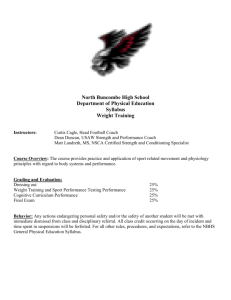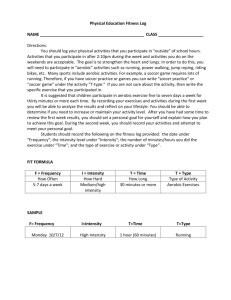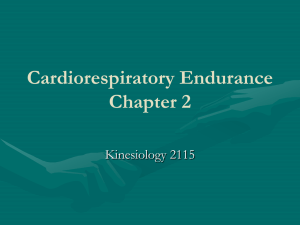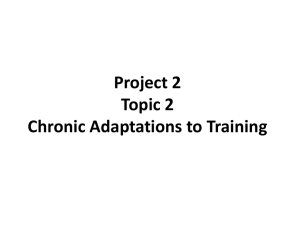LWW PPT Slide Template Master
advertisement
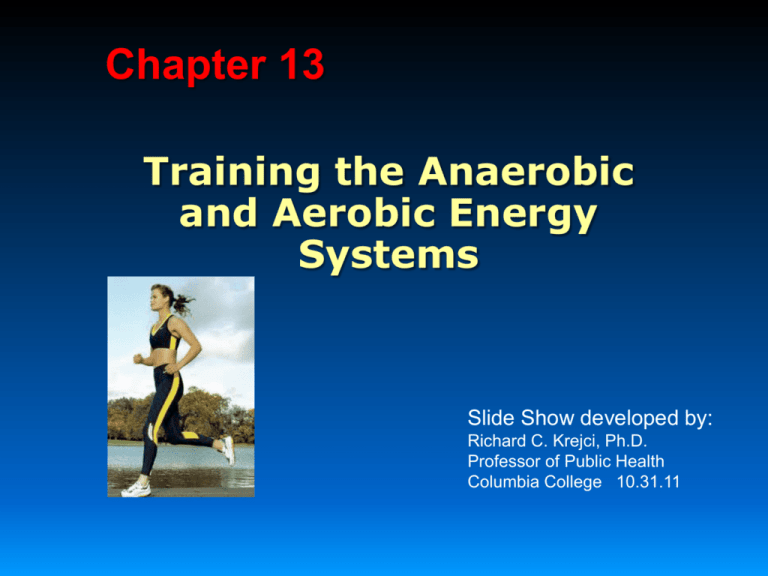
Chapter 13 Training the Anaerobic and Aerobic Energy Systems Slide Show developed by: Richard C. Krejci, Ph.D. Professor of Public Health Columbia College 10.31.11 Objectives 1. Define each of the following four principles of exercise training: (1) overload, (2) specificity, (3) individual differences, and (4) reversibility. 2. Discuss the overload principle for training the intramuscular high-energy phosphates and glycolytic systems. Outline the specific adaptations in each system with exercise training. 3. Describe how the following five factors affect an aerobic training program: (1) initial fitness level, (2) genetics, (3) training frequency, (4) training duration, and (5) training intensity. 4. List five cardiovascular and pulmonary adaptations to aerobic training. 5. Explain how exercise heart rate can establish the appropriate exercise intensity for aerobic training. Objectives (Cont.) 6. Define the training-sensitive zone. 7. Outline a typical exercise training session for aerobic fitness improvement. 8. Explain the need to adjust the training-sensitive zone for swimming and other modes of upper-body exercise. 9. Explain the influence of age on maximum heart rate and training-sensitive zone. 10. Contrast continuous versus intermittent aerobic exercise training, including advantages and disadvantages of each. 11. Outline five potential benefits and risks of exercising during pregnancy. General Training Principles • Overload Principle: The regular application of a specific exercise overload enhances physiologic function to produce a training response (improved health related fitness). • Specificity Principle: Adaptations in metabolic and physiologic systems that depend on the type of overload imposed and muscle mass activated (for example strengthening the legs in order to increase power or ability to jump higher in basketball) SAID Principle: Specific Adaptations to Imposed Demands • Individual Differences Principle: All individuals do not respond similarly to a given training stimulus. • Reversibility Principle: Detraining occurs relatively rapidly when a person quits their exercise training regimen (“Use it or lose it” principle) General Training Principles Adaptations to Exercise Training: Anaerobic System Changes • Increased levels of anaerobic substrates • Increased quantity and activity of key enzymes that control the anaerobic phase of glucose catabolism • Increased capacity to generate high levels of blood lactate during all-out exercise Adaptations to Exercise Training: Aerobic System Changes • Enhancement in a muscle fiber’s capacity to aerobically generate ATP • An increase in mitochondrial size and number • Two-fold increase in the level of aerobic system enzymes • An enhancement in both fiber types’ existing aerobic capacity and lactate threshold level Adaptations to Exercise Training: Aerobic System Changes Adaptations to Exercise Training: Aerobic System Changes • Improvement in the ability to oxidize fatty acids, particularly triacylglycerols stored within active muscle during steady-rate exercise • Enhancement in the capacity to oxidize carbohydrate • Provides for a considerably faster aerobic energy transfer than from fat breakdown • Liberates about 6% more energy than fat per quantity of oxygen consumed Adaptations to Exercise Training: Cardiovascular Adaptations • An increase in the heart’s mass and volume with greater left-ventricular end-diastolic volumes during rest and exercise • An increase in plasma volume • An increase in stroke volume at rest and during exercise • A reduction in heart rate during submaximal exercise Adaptations to Exercise Training: Cardiovascular Adaptations (Cont.) • An increase in maximum cardiac output • An increase in the maximum quantity of oxygen extracted from arterial blood during exercise • An increase in muscle blood flow during maximal exercise • A decrease in systolic and diastolic blood pressures during rest and submaximal exercise Adaptations to Exercise Training: Cardiovascular Adaptations (Cont.) Adaptations to Exercise Training: Pulmonary Adaptations • Improvements in maximal oxygen uptake with training increase maximal exercise minute ventilation • An improvement in the ability to sustain high levels of submaximal ventilation • A reduction in the ventilation equivalent for oxygen in submaximal exercise Adaptations to Exercise Training: Blood Lactate Concentration A decrease in blood lactate levels and an increase in exercise intensity before the onset of blood lactate accumulation Adaptations to Exercise Training: Body Composition Changes • For overfat or borderline overfat people, regular aerobic exercise reduces body mass and body fat • Increases in fat-free body mass accompany a regular program of resistance training • Exercise only, or exercise combined with calorie restriction, reduces body fat more than fat lost with only dieting Adaptations to Exercise Training: Temperature Regulation • Well-hydrated, aerobically trained individuals exercise more comfortably in hot environments because of a larger plasma volume and more-responsive thermoregulatory mechanisms. • Trained men and women dissipate heat faster and more effectively than untrained persons. • For trained individuals, the metabolic heat generated by exercise poses less of a detriment to exercise performance and overall safety. Adaptations to Exercise Training: Endurance Performance Changes • Enhanced endurance accompanies the physiologic adaptations with training. Adaptations to Exercise Training: Psychological Benefits • Regular exercise, either aerobic or resistance training, produces psychological benefits regardless of age. Four Major Factors Affecting the Aerobic Training Response 1. Initial Level of Cardiorespiratory Fitness: Considerable improvement occurs if initial fitness is low and an exceptionally high level of initial fitness leaves little room for improvement. 2. Training Frequency: In general, a training response occurs with exercise performed at least three times weekly for at least six weeks. 3. Training Duration: In general, performing less exhaustive, moderate-paced exercise for at least 30 minutes each session establishes a realistic exercise duration recommendation for the average person. 4. Training Intensity: Generally, 50-55% of VO2max or 70% HRmax is the minimal threshold stimulus for cardiovascular improvement. Exercise intensity represents the most critical factor for successful aerobic training. Trainability and Genetics • The limits for developing fitness capacity link closely to natural endowment due to genetics. • For two individuals in the same exercise program, one might show five to six times more improvement than the other. • Genetics research indicates a genotype dependency for much of one’s sensitivity in responding to maximal aerobic and anaerobic power training, including adaptations of most muscle enzymes. Recommended Rate of Progression for Aerobic Exercise Program Phase Beginning Improvement Maintenance Week Frequency Intensity Duration 1 3x/week 40-50% 12 min 2 3x/week 50% 14 min 3 3x/week 60% 16 min 4 3x/week 60-70% 18 min 5 3x/week 60-70% 20 min 6-9 3-4x/week 70-80% 21 min 10-13 3-4x/week 70-80% 24 min 14-16 3-4x/week 70-80% 24 min 17-19 4-5x/week 70-80% 28 min 20-23 4-5x/week 70-80% 30 min 24-27 4-5x/week 70-85% 30 min 28+ 3x/week 70-85% Source: American College of Sports Medicine Guidelines, 2005. 30-45 min Facts about Getting Started and Adhering to a Personal Exercise Program 50% of the people who begin an exercise program will quit within 6 months Exercise adherence is defined as any strategy that is used to help one to maintain a lifetime program of exercise. Consider the Current Exercise “Stage of Change” Determine the best “process” and behavior modification technique for your client. Intrinsic Motivation An intrinsically motivated person exercises because it is rewarding and enjoyable! Keys to Intrinsic Motivation • Optimal Challenge • Positive reinforcement • Enjoyment Children generally find activity to be intrinsically rewarding. What happens to many adults? Why do People Exercise? Key Motivation Factors Health Aesthetics Weight control Competition and challenge Fun Social interaction Mental arousal Relaxation Stress management Maintenance of Aerobic Fitness Gains • Aerobic capacity improvement involves somewhat different training requirements than its maintenance. • With intensity held constant, the frequency and duration of exercise required to maintain a certain level of aerobic fitness remain considerably lower than required for its improvement. • A small decline in exercise intensity reduces VO2max, indicating that exercise intensity plays a principal role in maintaining the increase in maximal aerobic capacity (cardiorespiratory endurance) achieved through training. Tapering for Peak Performance • In most instances, little improvement occurs in the aerobic systems during the competitive season. • Before major competition, athletes often reduce or taper training intensity and/or volume. • From a physiologic perspective, four to seven days probably provides sufficient time to achieve maximum muscle and liver glycogen replenishment, optimal nutritional support and restoration, minimize residual muscle soreness, and speed healing of minor injuries. Three General Guidelines to Formulating an Aerobic Training Program • Start slowly • Allow a warm-up period • Allow a cool-down period Exercise Guidelines for Children • Children are not small adults. • Accumulate more than 60 minutes, and up to several hours daily, of age and developmentally appropriate activities for elementary school children. • Some of the child’s physical activity each day should be in periods lasting 15 minutes or longer and include large muscle, rhythmic moderate to vigorous aerobic activity. • Extended periods of inactivity are not appropriate for normal, healthy children. • Elementary school children should participate in a variety of physical activities of various levels of intensities. Establishing Training Intensity • Exercise intensity must be assessed relative to the stress it places on a person’s aerobic system. Train at percentage of VO2max Train at percentage of maximum heart rate • HRmax = 220 - age in years Train at perception of effort • Rating of perceived exertion (RPE) Train at the lactate threshold Establishing Training Intensity (Cont.) Methods of Training • Anaerobic Training: All-out exercise for up to 60 seconds • Continuous Training: Continuous (long slow distance) training that requires sustained, steady-rate aerobic exercise • Interval Training: Specific spacing of high intensity exercise and rest periods • Fartlek Training: The performer determines the training schema based on “how it feels” at the time, in a way similar to gauging exercise intensity based on one’s rating of perceived exertion. Overtraining Syndrome • Two clinical forms of overtraining have been described: Sympathetic form: Characterized by increased sympathetic activity during rest and is generally typified by hyperexcitability, restlessness, and impaired exercise performance Parasympathetic form: Characterized by predominance of vagal activity during rest and exercise Overtraining Syndrome Symptoms • Unexplained and persistently poor athletic performance and high fatigue ratings • Prolonged recovery from typical training sessions or competitive events • Disturbed mood states characterized by general fatigue, apathy, depression, irritability, and loss of competitive drive • Persistent feelings of muscle soreness and stiffness in muscles and joints • Elevated resting pulse, and increased susceptibility to upper respiratory tract infections and gastrointestinal disturbances • Insomnia • Loss of appetite, weight loss, and inability to maintain proper body weight for competition • Overuse injuries Exercise Training During Pregnancy • An uncomplicated pregnancy offers no greater physiologic strain to the mother during moderate exercise other than provided by the additional weight gain and possible encumbrance of fetal tissue. • Increases in maternal body mass add considerably to exercise effort in weight-bearing activities. • 30 or 40 minutes of moderate aerobic exercise by a previously active, healthy, low-risk woman during an uncomplicated pregnancy does not compromise fetal oxygen supply, acid-base status, or produce other adverse effects to mother or fetus. • Regular aerobic exercise throughout pregnancy accomplishes the following: Reduces birth weight Reduces birth weight percentile Reduces the offspring’s calculated percentage body fat and fat mass Contraindications for Exercising During Pregnancy • Pregnancy-induced hypertension • Pre-term rupture of membranes • Pre-term labor during the prior or current pregnancy • Incompetent cervix • Persistent second to third trimester bleeding • Intrauterine growth retardation • Type 1 diabetes • History of two or more spontaneous abortions • Multiple pregnancy • Smoking • Excessive alcohol intake • History of premature labor • Anemia • Excessive obesity The End
